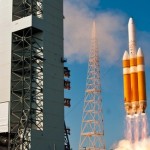 President Barack Obama’s Defense Department budget request released Monday shows that the route to technological breakthroughs is often winding.
President Barack Obama’s Defense Department budget request released Monday shows that the route to technological breakthroughs is often winding.
Last year, Defense Secretary Chuck Hagel announced a new “offset strategy” to develop breakthrough solutions to secure American technological dominance into the next century. This year, the budget request increases money for research and development by about $500 million, bringing it to $13.5 billion.
It will be a great year for futuristic technologies that sound like they come from a comic book. But the budget also shows that every new invention has consequences and can raise new problems even as it solves others.
Obama requested a slight increase in spending for the Defense Advanced Research Projects Agency, or DARPA, which would bring their budget to $3 billion to work on next generation technology related to everything from synthetic biology to space planes. Money for electronic and laser weapon systems jumped to $67 million from a bit over $55 million last year.
For the first time, the budget allocates some $41.8 million for unmanned aerial vehicle “integration and interoperability.” That’s part of strategic plan rolled out in 2013.
The document lays out a wish list of capabilities for the drones of tomorrow. They include the ability to process vast amounts of sensed data rather than just transmit it, stay over a target for days and communicate with a wider variety of other systems. The missions also expand from just ISR and close ground support to air combat (presumably drone on drone) and even “non-lethal crowd control.”
The request also asks for 29 new Reaper drones, which are in demand to fight terrorism, a larger buy than last year. Not all drones fared well, however.
The Navy’s Unmanned Carrier Launched Airborne Surveillance and Strike, or UCLASS, drone was basically sent back to the drawing board for a year. The program saw a drop of funding from more than $400 million down to just $134 million.
It’s the surest signal yet that the military increasingly understands that some of the most innovative thinking in technology is happening outside of the Pentagon
Many drone proponents were actually pleased. Paul Scharre, a senior fellow at the Center for a New American Security has long argued that the UCLASS was poorly conceived, overloaded with intelligence capabilities and capable of 14 hours of uninterrupted flying. Program detractors like Shawn Brimley, executive vice president of the Center for a New American Security, at a House Armed Services Committee hearing last year said that the plane should be reconsidered as more of a fighter with better weapons, even if that made it heavier. In fact, the entire fate of the aircraft carrier as a credible projection of power depended on it.
“It’s a question of ensuring that the aircraft carrier can project (and sustain) power over longer ranges. I don’t think the carrier air wing will be able to be all that effective in the future if we don’t develop something like a UCAV,” he said referring to a sizable drone that can provide real combat support to fighter jets, or that “that can complement other strike capabilities in the air wing,” and not just take pictures.
Navy representatives last year told the committee, “Frankly, that does not exist. It’s not technically achievable today.”
Perhaps next year?
The military has its eyes turned again to space. The budget requests $7 billion for Defense Department space programs. Expenditures for Navy satellite communications systems rose from $11 million to nearly $21 million. Spying from space also became more expensive. The request for space-based reconnaissance jumped from $78 million to $100 million this year. Architecture and support for space electronic warfare rose from $18 million to nearly $30 million. The Air Force space situation awareness program rose from $9 million to $32 million (in the form of two satellites) and the nation’s $200 million dollar “space fence” a system to track bits of space debris and objects orbiting the Earth, received more money, bringing the total cost for that program to $243 million.
{Matzav.com Newscenter}












A real steel and concrete border fence would cost hundreds of billions of dollars — nobody would be willing to raise taxes for that. And it would do nothing about the approximately 40% of illegal aliens who come to the US legally and overstay their visas. Remember that all 19 9/11 terrorists came to the US legally.
charlie-first of all what part of “in outer space” confused you? no one said anything about steel and concrete, and the aliens that come from outer space are only in science fiction. second, the left is ok with raising taxes for everything else, so they shouldnt have a problem actually doing something productive with that money, instead of supporting generations of couch potatoes. third, if you had a drink which you learned was poison, would you keep drinking because stopping wont do anything about the poison that is already in your body, or would you stop and get help? we should stop the 60% who come illegally and then worry about the 40% here.